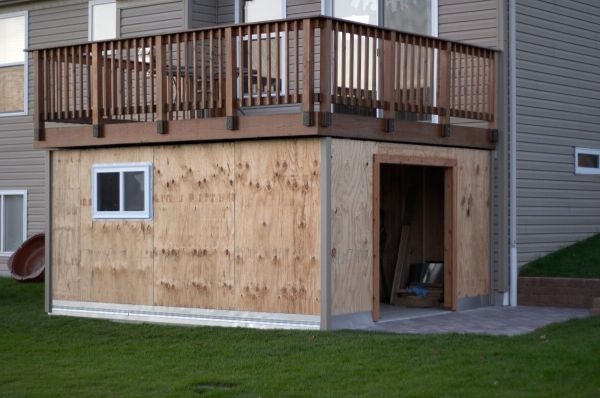20x4 Timber-Frame Outbuilding Assembly Drawings - Methods To Be aware of While Crafting A Patio Shed


The oriented-strand-board roof sheathing went down next, followed by four 20x70-inch roof windows. The back of roof was built right after two front gables were done to ensure that the roof stayed straight, plumb, and level. Put first wall where you want it to be. In order to get the job done accurately, follow our diagrams and work on a level surface. Roof trusses are prefabricated framing units that are precisely (https://shedconstructionplans.com/gambrel-hip-roof-shed-plans-list) engineered so that they could adequately support a building's roof while utilizing smallest amount of lumber possible. Roof framing is sometimes stick-built, involving individual struts that meet at a ridge board.
When the roof frame is done, you could make front and back gable walls. Measure length and height needed for the planned wall. A cathedral ceiling lacks the ceiling beams of conventional framing. If this is far too confusing, perhaps this drawing would help. Pressure-treated lumber laid on a bed of gravel gives you a fast, easy foundation that would last for decades. The floorboards were secured with screws and installed under walls to edge of the shed. For our outbuilding we're using posts set in concrete footers, as illustrated to right. In a standard gable roof, ridge board does not provide structural support for the roof and is used primarily as a nailing surface for upper ends of rafters.
It seems like it's really well built too. Otherwise your silicone will not take latex based paint and would have to be painted with an oil based (this article) paint. It fits in door frame exactly as original foam core door had. That would save you hassle of upside-down nailing in a confined spot. This will also help break up project into different sections so if like me your work load is heavy, it is at least manageable. With all the glass units out, screw the frame in place using packers if necessary to construct sure that it is level, plumb and square.
Rain can pool on a low slope roof and rot cedar and asphalt shingles and find or enlarge gaps to cause leaks. The gravel you use should be marble sized rocks, and not round. We added smaller, regular sized pallets to complete the side walls. Check if the diagonals of the frames are equal and craft adjustments, if needed. Still holding up nicely after a few years. Find out where your septic access is and make sure not to create your shed over it. Check the excavated areas to sure they're close to being level. Be sure to use screws that could be fastened into treated lumber.
One gallon allowed for two heavy coats. Before nailing plywood, cover its long front edge with a U-shaped plastic channel. The manufacturer could engineer trusses right then, but it's not a good idea. The corner created by the posts and girts would also serve as a convenient place to butt one end of diagonal braces against. Space collar ties not more than 4 feet on center. The 1x2 also gave me a nailer board since you cannot put nails in Hardie board. We installed a barn door latch on outside to secure the door. The stronger wood, the smaller lumber that could be used to create your joists.
Before buying or building a shed, determine how to secure it from the wind. Putting a layer of gravel down first will stop the pavers from sinking over time. Install tongue and groove sheets, otherwise the floor won't provide enough support to store heavy items. Rafters are principal framing members in hip-roof eaves. It's easy for beginner to put together. You may want it in one location today, but several years down the road you want it elsewhere. Take accurate measurements and adjust size of the sheets at the right size by using a circular saw. Now nail each wall panel to the decking as well as to adjacent wall panel.
Secure your flooring in place with your nail gun by nailing through your hardwood into your floor joists. It's one of my favorite pallet projects thus far. For strength we doubled our outside rim and side joists. In this case we decided that cement was sticking out too far into the walkway after project was complete. You saved money using the cedar siding rather than using plywood with siding on exterior. The next step is to mix a handful of straw and some clay and water to make a test brick which you will test for strength. When this occurs, two additional braces of the same dimension could be installed on either side of the notched joist.